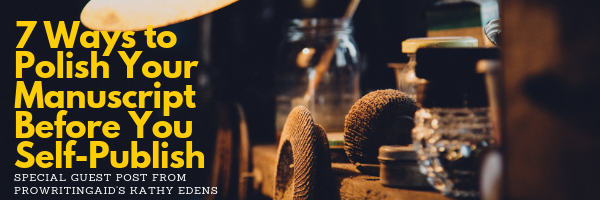Publishing is a competitive industry whether you self-publish or go the traditional route. Polishing your manuscript until it’s the best it can be is even more important for the self-published author. When you publish your own work, you likely don’t have an entire team of editors and industry experts to help bring your book to market.
Here are seven ways you can polish your manuscript before you self-publish.
1. Print your manuscript out.
You’ve stared at the computer screen for a relatively long time. By now, your eyes are skimming the words, not reading them thoroughly. When you print out your manuscript, you see it in a different form, so it’s easier to pinpoint problems.
Print your manuscript in a clear typeface with easily readable black font. Then sit down with a red pen and read. You’re looking for the deeper mistakes like character and narrative arc, how well you executed your plot, and if those elements of your story are consistent and logical throughout.
Don’t worry about polishing prose. You’re not analyzing your manuscript at the sentence level; you’ll get to that soon enough. Instead, pay attention to deeper missteps.
A great way to go deeper is to write one clear, concise sentence that encapsulates what your novel is about. If you can’t narrow it down to its essential core, your story idea might need more focus.
Once you have your single sentence, your elevator pitch, make sure each paragraph lives up to the promise in your pitch. It you find entire chapters that don’t relate to your elevator pitch, you’ve got some rewriting to do.
2. Read the dialogue out loud.
Dialogue that doesn’t flow off your tongue as you read aloud needs work. In fact, read your entire manuscript out loud.
Check for pacing as you read. Where does your story slow down? This is particularly important in the middle chapters where you’re trying to move the plot forward and maintain your readers’ interest.
Look for information dumps or long descriptions. If you spend a page and a half on the setting for a particular chapter, you’re likely to lose your readers. It’s easy to meander while you’re drafting your story; now is the time to rethink certain passages or scenes that don’t move your readers forward.
3. Replace your weaknesses with strengths.
You know your strengths and weaknesses as a writer. Are you weak in setting, or maybe using too much backstory? Maybe you struggle to make your villains anything other than one-dimensional. Whatever your weaknesses, take the time to scour your manuscript for them. Wherever you’re weak, the text will be lackluster.
Mark Twain told writers to “forget their weaknesses and attack their strengths.” If you feel your piece is weak, go back through and exploit your strengths instead.
Are you fantastic at character development? Make sure all your characters are multi-dimensional and fully fleshed out. Are you into world-building? Spend extra time on making a different world feel as real as our own. You may find when you go back through that your weaknesses aren’t as obvious afterwards.
4. Cut your sentences down.
Your manuscript has excess wording. All manuscripts do. That’s why so many famous authors tell you to “Kill your darlings.” Sure, it sounds good to you; you wrote it. But does it advance the story? If not, it should go.
Try to cut your sentences in half. Pretend like you have a word or page limit and rid your prose of any dangling bits that offer no substance. Trust your reader to understand your subtext—you need not explain everything.
5. Use an editing tool
Now is when you get nit-picky. Beyond looking for spelling, punctuation, grammar, and more, carefully read your manuscript for inconsistencies. Make sure your characters’ names or details don’t change as your story moves forward. Look for stylistic improvements like eliminating passive verbs, adverbs, and long subordinate clauses.
The best way to perform a line-by-line edit is to use an online editing tool like ProWritingAid. You can run your manuscript through 20+ reports that find everything from clichés and overused words or phrases to vague and abstract wording.
The beauty of using an online editing tool is it makes simple suggestions for improvement. You determine what and how you want to change your manuscript, so you never lose your authentic voice.
6. Find beta readers.
The second most important tip before self-publishing: find beta readers who you trust to give you honest feedback. Your beta readers should offer constructive criticism without worrying about hurting your feelings.
The focus is on constructive feedback. While your ego wants to hear how wonderful your story is, your inner editor needs to hear what didn’t work and what needs strengthened.
If you don’t have beta readers lined up, join a writers’ group on social media or a local writing club. Don’t just beg people to read your work; offer yourself as a beta reader in return.
7. Hire a human editor.
Finally, the most important tip:
Nothing can replace an experienced editor’s eye.
Your editor should not only edit, but critique and coach you to get the best work out of your manuscript. A great editor will help bring to the surface the book you intended and the one you are most capable of writing.
All manuscripts need a professional’s eye. Even the most renowned writers have an editorial team, usually at their publishers, to make their books great. Find yourself a true professional with the credentials and extensive experience to back it up. The good ones don’t come cheap but they’re well worth the money spent.
Now your manuscript is ready to self-publish.
Kathy Edens is a blogger, content master and regular contributor to the ProWritingAid Blog. She loves writing about anything and everything. Check out her books:20 Editing Tips from Professional Writers, The Novel-Writing Training Plan and Creating Legends: How to Craft Characters Readers Adore… or Despise.
